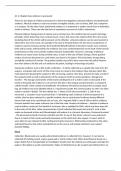AC 1.3 Explain how evidence is processed
There are two types of evidence processed in criminal investigations: physical evidence and testimonial
evidence. Physical evidence is real and consists of tangible articles, such as blood, DNA, hair, footprints
or a weapon. On the other hand, testimonial evidence is a statement or spoken words from a defendant,
victim or witness. These can take the form of eyewitness accounts of victim's statements.
Physical evidence being present in almost every criminal case, this could be due to Locard’s Exchange
principle, which states that every contact leaves a trace, this means the material from the crime scene
(including that of the victim) will be present on the offender - physical evidence can be seen touched or
observed in any crime scene. An example is the case of Amanda Knoxx, the two most crucial pieces of
evidence used to tie Knoxx and her then boyfriend Rafaell Sollecito to Kerchers murder were a kitchen
knife and bra strap. Unfortunately, the evidence was cross contaminated due to the fault of the forensic
professionals on the scene and the evidence became inadmissible. However, exchange of physical
evidence can cause issues during criminal cases, as seen in the case of Barry George, where gunshot
residue of one ten thousand of a centi-metre was found in his jacket. This led to Barry George being
wrongfully convicted of murder. The gunshot residue was said to have come from the police firearms
that were taken to his flat and so it ended on his jacket, leading to miscarriage of justice.
Impression evidence such as bite marks. Collection – It will be collected as a sample bite mark from the
suspect, and police will corner off the crime scene to conserve the evidence they will also collect bite
mark placement by giving the suspect to bite on leaving a patent, then they proceed to make a mold of
the suspects teeth as well as take photos of the suspects mouth in various positions. Storage and
transfer – The storage and transfer of bite marks will depend on if a victim is alive or deceased. If the
victim is deceased, the evidence is cut out from the skin in the morgue and preserved in a compound
called formalin, which contains formaldehyde. All evidence will need to be placed into a tamper proof
bag, all evidence has to be labelled which is a requirement under the criminal justice act 1967, the label
needs to contain 4 details. The four details are: 1. Name of CSI who recovered it. 2. Date it was
recovered. 3. Location it was recovered from. 4. Identifying mark. Evidence is then transported in a
vehicle, that has been selected in a specific method, due to each physical evidence having different
factors that need to be considered such as heat, rain, magnetic field in case of USB or device evidence.
Forensic dentists then make a silicone cast of the bite mark. Analysis of evidence – Analysis of evidence
need to follow a protocol, first identify it as human, bite is swabbed for DNA, which may have been left
in the saliva of the biter, takes measurements of each individual bite mark and record it, such as bite
marks on deceased victims and Odonatologist will analyse it in a forensic laboratory. Personnel involved
– the personnel involved is forensic scientists and CSI. A case of ‘Ray Krone’ where he was sentenced
due to a match of bite marks and teeth placement on the victim from the suspect. It wasn’t until 10
years later he was released to DNA testing proving his innocence. DNA testing conducted on the saliva
and blood found on the victim excluded Krone as the source and instead matched a man named
Kenneth Phillips.
Blood
Collection- Blood pools are usually where blood evidence is collected from, however, it can also be
collected off clothing aswell, using a gauze pad or sterile cotton cloth. When dried blood is found on a
larger object that is transportable an investigator should cover the stained area with paper and tape the
paper to the object to avoid contamination. Flakes of dried blood can be scraped and collected from an





